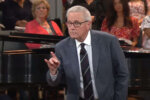Results show employers prefer a college curriculum that provides hands-on experience.
Leaders of Christian COLLEGES and universities who have made an
effective case for teaching students to love God with their minds are
now exploring the opportunities afforded by service learning to teach
them to love God with their hands and feet as well. Providing such
opportunities strengthens an institution’s academic programs, draws
students who are highly motivated to serve others and positions them to
benefit from the educational results of experiential learning.
Service learning is the integration of community service with
academic instruction and structured reflection. Students engaged in
service learning are briefed on theory, apply the theoretical
principles to real-world problems and then reflect upon the
effectiveness of the exercise to improve themselves for future service.
This pedagogical tool, which puts God’s love in action,
produces social, educational, personal and spiritual results. First of
all, people are helped. Whether service learning takes the form of
accounting students assisting others with tax preparation, education
students tutoring children, or government students guiding immigrants
through the process of acquiring citizenship, problems are addressed
and issues resolved.
Second, learning is enhanced because students see the immediate
benefits of service to others. When students understand the relevance
of real-life lessons, they are more likely to become interested in the
learning process. The excitement generated by purpose-rich activity
fuels their passion for service, motivating them to pay the price for
excellence. Doing motivates learning.
Third, students acquire social and leadership skills that not
only make them more fit for service but also prepare them for the
workforce. In a January 22, 2008, press release, the Association of
American Colleges and Universities announced the results of a study
that surveyed 301 employers.
Results showed employers prefer a college curriculum that
provides hands-on experience that can be applied in the real world.
Robert T. Jones, president of Education and Workforce Policy, said,
“One important message from this study is that colleges need to develop
more opportunities for students to apply what they are learning in
real-world settings.”
Fourth, serving others through an educational experience
enables students to develop wisdom as they acquire knowledge. Wisdom is
the intelligent application of knowledge. It’s not just what you know but how you use what you know.
Though experience can “teach” wisdom, wisdom is not an
inevitable result. Students may have been present for educational
experiences, but did they learn anything? It is the powerful
combination of enlightened guided experience with reflection afforded
by service learning that makes it an effective way to teach wisdom.
Fifth, in serving others, students have their personal needs
met. The seed-faith principle of sowing and reaping works. Albert
Schweitzer said, “Only those of you who have sought and found how to
serve will be truly happy.”
Finally, loving God with our hands and feet through service
learning is a viable way to carry out Christ’s mandate of loving our
neighbors as ourselves. Though secular institutions also offer service
learning, Christian colleges and universities—particularly charismatic
ones—should lead in demonstrating the fruit of the Holy Spirit.
An example of service learning—and of true religion—is taking
care of widows and orphans (see James 1:27). A story from World War II,
as related in a book by Paul Brand and Philip Yancey titled Fearfully and Wonderfully Made, illustrates the service concept well:
“After World War II, German students volunteered to help rebuild
a cathedral in England, one of many casualties of the Luftwaffe
bombings. As the work progressed, debate broke out on how to best
restore a large statue of Jesus with His arms outstretched and bearing
the familiar inscription, ‘Come unto Me.’ Careful patching would repair
all damage to the statue except for Christ’s hands, which had been
destroyed by bomb fragments. Should they attempt the delicate task of
reshaping those hands?
“Finally the workers reached a decision that still stands
today. The statue of Jesus has no hands, and the inscription now reads,
‘Christ has no hands but ours.’ ”
Ralph Fagin, Ph.D., is the interim president of Oral Roberts University in Tulsa, Oklahoma.






Leave a Comment
You must be logged in to post a comment.